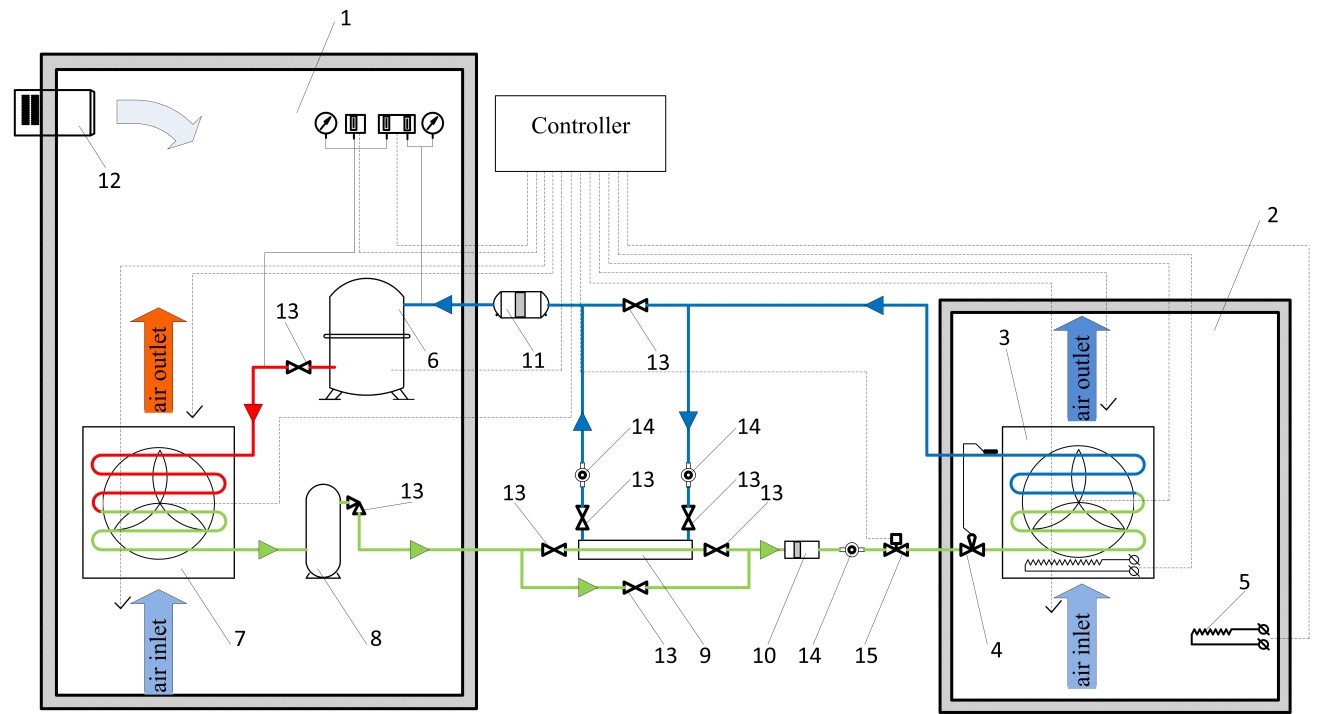Experimental study of the solid fouling effect on the air-cooled apparatus characteristics
DOI:
https://doi.org/10.5604/01.3001.0014.7531Keywords:
air condenser, fouling, experimental bench, heat exchange surfaceAbstract
External fouling on the heat exchange surface of air-cooled apparatus are formed during operation, which leads to a significant increase in energy consumption and deviations from the optimal operating mode of the entire system. This phenomenon is a problem for all energy conversion systems. This paper presents the experimental study results of a complex of a commercial cooled object with real fouling on the air condenser surface. To study the effect of fouling, an experimental bench was developed – a single-stage refrigerating machine that provides cold supply to a thermostatic chamber. Three types of fouling were used: sand, fluff and dust. Fouling were picked from the operating condensers and identical in the type of heat exchange surface to the experimental sample. With a change in the quantitative and qualitative composition of the fouling, the air condenser thermal and aerodynamic characteristics and the energy efficiency of the machine as a whole were determined. The experiment showed that at maximum fouling of the heat exchange surface with sand and fluff, air movement stops. This means that at a certain thickness of sand and fluff layer, an air impermeable dense structure is formed. Dust with the same form of filling the free space for the flow remains permeable to air. Experiments showed that the qualitative composition of the fouling is the main factor that determines the heat exchanger performance. It was found that from the experimental set of fouling, roadside dust has the greatest negative effect on the condenser characteristics and the machine as a whole. The aerodynamic properties of the heat exchanger depend to some extent on the qualitative composition of the fouling. As a conclusion, it was suggested that the process nature of air flow passing through the investigated fouling can be described as gas flows in porous media.
Downloads
References
Ladislav N. Fouling of compact heat exchangers. Alfa-laval. [Internet] 2004. [cited 2020 Dec. 19]. Available from: www.alfalaval.com. Google Scholar
Bhuiyan AA, Amin MR, Islam AS. Three-dimensional performance analysis of plain fin tube heat exchangers in transitional regime. Applied Thermal Engineering. 2013;50(1):445–454. doi: https://doi.org/10.1016/j.applthermaleng.2012.07.034. Google Scholar
Awais M, Bhuiyan AA. Heat and mass transfer for compact heat exchanger (CHXs) design: A state-of-the-art review. International Journal of Heat and Mass Transfer. 2018;127(part C):359–380. doi: https://doi.org/10.1016/j.ijheatmasstransfer.2018.08.026. Google Scholar
Bhuiyan AA, Islam AS. Thermal and hydraulic performance of finned-tube heat exchangers under different flow ranges: A review on modeling and experiment. International Journal of Heat and Mass Transfer. 2016;101:38–59. doi: https://doi.org/10.1016/j.ijheatmasstransfer.2016.05.022. Google Scholar
Ahn YC, Lee JK. Characteristics of air-side particulate fouling materials in finned-tube heat exchangers of air conditioners. Particulate Science and Technology. 2005;23(3):297–307. doi: https://doi.org/10.1080/02726350590955930. Google Scholar
Yang L, Braun JE, Groll EA. The role of filtration in maintaining clean heat exchanger coils. Final Report no. ARTI-21CR-611-40050-01. Air-conditioning and Refrigeration Technology Institute (ARTI); 2004. doi: https://doi.org/10.2172/833362. Google Scholar
Ali AH, Ismail IM. Evaporator air-side fouling: Effect on performance of room air conditioners and impact on indoor air quality. HVAC & R Research. 2008;14(2):209–219. doi: https://doi.org/10.1080/10789669.2008.10391004. Google Scholar
Bell IH, Groll EA. Experimental comparison of the impact of air-side particulate fouling on the thermo-hydraulic performance of microchannel and plate-fin heat exchangers. In: The International Refrigeration and Air Conditioning Conference. Purdue: Purdue University; 2010. Paper 1024. Available from: http://docs.lib.purdue.edu/iracc/1024. Google Scholar
Mehrabi M, Yuill D. Evaluation the effect of washing on the heat transfer capacity and air-side flow resistance of air cooled condensers. In: The International Refrigeration and Air Conditioning Conference. Purdue: Purdue University; 2018. Paper 1884. Available from: http://docs.lib.purdue.edu/iracc/1884. Google Scholar
Mehrabi M, Yuill D. Fouling and its effects on air-cooled condensers in split system air conditioners (RP-1705). Science and Technology for the Built Environment. 2019;25(6):784–793. doi: https://doi.org/10.1080/3744731.2019.1605197. Google Scholar
Mehrabi M, Yuill D. A laboratory test method to realistically simulate ir side fouling of condensers (RP-1705). Science and Technology for the Built Environment. 2020;26(6):805–815. doi: https://doi.org/10.1080/23744731.2020.1737489. Google Scholar
Yifeng Hu, Yuill D, Ebrahimifakhar A. The effects of outdoor air-side fouling on frost growth and heat transfer characteristics of a microchannel heat exchanger: An experimental study. International Journal of Heat and Mass Transfer. 2020;151:19423. doi: https://doi.org/10.1016/j.ijheatmasstransfer.2020.119423. Google Scholar
Morozyuk LI, Sokolovska VV, Gaiduk SV, Moshkatyuk AV. Metod eksperymental’noho doslidzhennya povitryanykh kondensatoriv malykh kholodyl’nykh mashyn i teplovykh nas [= Method of experimental investigation of air-cooled condensers for small refrigeration machines and heat pumps]. Refrigeration Engineering and Technology. 2017;53(3):4–11. doi: https://doi.org/10.15673/ret.v53i3.674. Google Scholar
Morozyuk TV. Theory of refrigeration machines and heat pumps. Odessa: Studio “Negotsiant”; 2006. Google Scholar
Kakaç S, Liu H, Pramuanjaroenkij A. Heat exchangers: Selection, rating, and thermal design. 3rd ed. Boca Raton: CRC Press; 2012. Google Scholar
Martynenko OG. Handbook of heat exchangers. Vol. 2. Moscow: Energoatomizdat; 1987 [in Russian]. de Boer R. Theory of porous media. Berlin–Heidelberg: Springer; 2000. Google Scholar

Downloads
Published
How to Cite
Issue
Section
License
Copyright (c) 2021 Authors

This work is licensed under a Creative Commons Attribution-NonCommercial 4.0 International License.



